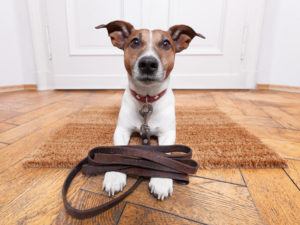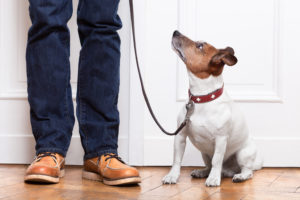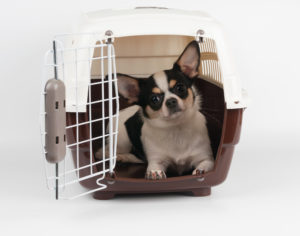You are running late and need to leave for work. You say goodbye to your beloved pooch and open the front door to leave. Just then your pup gets a twinkle in his or her eye and out the door they bolt with you running behind them yelling for them to come back, pleading with them to come back, begging them to come back, but your adorable dog is playing keep away and catch me if you can. Ugh! You are going to be late for work, again! If only you have gotten out the door faster! But wouldn’t a better way be that your dog had waited at the door and never went through unless he or she was granted permission to do so? Teaching your dog to wait at the door will not only help you get to work on time but may save your dog’s life.
Here is a Step by Step Guide to Teaching Wait at the Door:
Start working on this exercise when you have time. Do not start working on this when you are in a hurry, you are distracted, you are stressed, or your dog needs a walk or potty break.
Step One
You will start teaching wait at the door with your dog on a leash. Have him or her sit at the door and slowly turn the doorknob. If your dog continues to sit open the door slowly, an inch or two at a time. If your dog gets up and moves towards the door, take your hand off the knob or close the door and try again. Be careful when you are closing the door that you do not close it on your dog. You want to keep your training sessions short and end on a high note, so if your dog will sit and wait at the door while you turn the doorknob, give him or her a release word such as “okay” or “let’s go” and take them for a nice walk. Unless your dog does not enjoy walks, the act of taking him or her for a walk should be reward enough.
When you get back from your walk you can have another short wait at the door training session. Make sure you use your release word and take another short walk.
Step Two
Step two is the same as step one, but just a little more difficult for your dog. Open the door a little wider and ask your dog to “wait” for a second or two. If your dog gets up, make sure you close the door and try again. If your dog stays put for a second or two use your release word “okay and take your dog through the door and for a quick walk. When your dog can wait at the door without trying to walk through the door a minimum of four out of five tries you can proceed to make it even more difficult with the exercises in Step Three.
Step Three
Now you will challenge your dog by opening the door even wider. Work on this until you can have the door fully open and your dog will not attempt to go through unless you give him or her the release word.
This is only the beginning! Work on this behavior with your dog exiting their crate and your car. And just because your dog knows to wait at your front door doesn’t mean he or she will know to wait at your back door, so you will need to work in different locations within your home too. You will also need to work on how long your dog will wait at the door and you will want to proof for distractions. It’s great that your dog will wait at the door when there is nothing going on, but will he or she wait if another dog walks by? You will also want everyone in your home to work with the dog. Your dog may wait at doors for you, but not your spouse.
While having a polite dog who waits at doors is wonderful, it could also save your dog’s life. A dog that knows to wait at the door is at less risk of getting lost or bolting into traffic.
Have you tried this exercise? What is your biggest challenge? Let us know!




Trackbacks/Pingbacks